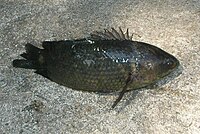|
Anabas testudineus
The climbing perch (Anabas testudineus) is a species of amphibious freshwater fish in the family Anabantidae (the climbing gouramis). A labyrinth fish native to Far Eastern Asia, the fish inhabits freshwater systems from Pakistan, India, Bangladesh and Sri Lanka in the west, to Southern China in the east, and to Southeast Asia west of the Wallace Line in the south. It is likely that Anabas testudineus is a species complex, with the binomial name applied to what are actually several different species. With further study, populations of this fish may be divided up into separate species and given new names.[1] In Nepalese Terai it is called "Pothiya". In Bengali it is called "দেশি কৈ" (Deshi Koi). In maithili spoken in Bihar it is called Kabai.In Indonesia, it is known by many names, such as betok (Indonesian), běthik (Javanese), and papuyu (Banjarese) The climbing perch is euryhaline and can grow to 25 cm (9.8 in) in total length.[2] Outside its native ranges, it is an invasive species that can live without water for 6–10 hours[3] and move on land by crawling/wriggling the body with its pectoral fins. It is believed that the fish may be invading new territories by slipping aboard fishing boats. The fish has been established in some islands east of the Wallace Line, in eastern Indonesia and Papua New Guinea, and is also believed to be advancing toward Northern Australia. In late 2005, the fish was discovered on Saibai Island and another small Australian island in the Torres Strait north of Queensland, about three to four miles south of Papua New Guinea.[4] TaxonomyThis species was first described by Marcus Elieser Bloch in 1792.[5] As foodThe climbing perch is important as a food fish in certain regions of South Asia and Southeast Asia, where its ability to survive out of the water for extended periods of time, provided it is kept moist, improves its marketability.[2]
In faithIn Thailand, the climbing perch can be found throughout every region and every type of water resource, it is normally consumed as food. In the beliefs of Thais, it is believed that if this species of fish is released it will help ward off disease. Because its common name in Thai is pla mo (ปลาหมอ, pronounced [plāː mɔ̌ː]), literally translated as "physician fish".[6] See alsoReferences
External links
|
||||||||||||||||||||||||||||||||||||||||




